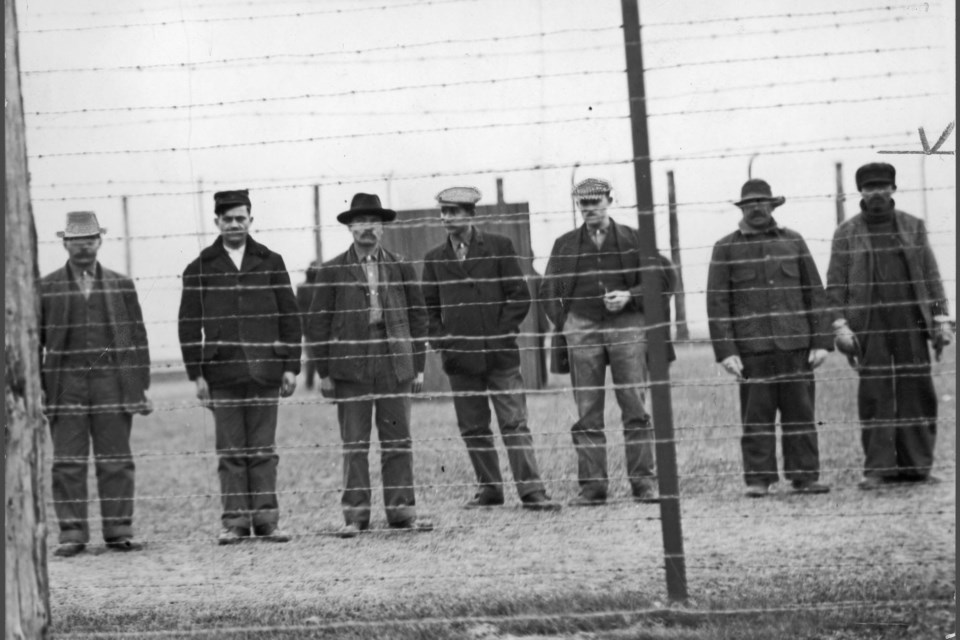DETAILS
Enemy Aliens: Internment in Canada, 1914-1920
Until Sunday, Jan. 19, 2020
Musée Héritage Museum (St. Albert Place, 5 St. Anne St.)
Call 780-459-1528 or visit museeheritage.ca for more information
It’s a telling sign of a piece of this nation’s history. The barbed wire lining the cattle-style chute as you enter the Musée Héritage Museum’s new exhibit might make you wary of getting too close. It isn’t real steel and therefore not at all sharp, but it sure makes a point.
Internment camps weren’t friendly, welcoming places.
Enemy Aliens is the museum’s newest exhibit and it explores what happened to thousands of people of foreign descent during the First World War. The promotional materials for the show, which was developed by the Canadian War Museum in partnership with the Ukrainian Canadian Civil Liberties Foundation), are quick to point out that the descriptive phrase ‘enemy aliens’ was commonly used to describe citizens of states that were at war with the British Empire but who resided in Canada at the time.
At the war’s outset in August 1914, the Canadian government enacted the federal War Measures Act (WMA), allowing it the ability to suspend or limit anyone’s civil liberties in the interest of the country’s protection. This included the right to incarcerate those very same ‘enemy aliens’ without any charges or any trials.
From that point until 1920, the federal government interned 8,579 people, mostly Ukrainians, identified as enemy aliens in a network of 24 camps across Canada. Slightly more than 3,100 were considered prisoners of war, while the others were simple civilians. In addition to those who were interned, another 80,000 ‘enemy aliens’ – again, mostly Ukrainians – were mandated to carry identity papers all the time and to regularly report to local police offices.
When you think of “Canada, the true north strong and free,” this is not necessarily the first piece of history that arrives to mind.
“It's an important show. I think it reminds us in the First World War of Canada's enormous contributions overseas, but at home, of course, there were infringements on civil liberties and this is probably the most egregious case of that,” explained Dr. Tim Cook, the Canadian War Museum’s First World War historian. “It's one of those topics that I think for many years was neglected by historians in our schools.”
The display comes to the Musée Héritage Museum for a two-month run in advance of the 100th anniversary of the end of the First World War internments. Of course, other internments happened in the Second World War, but the travelling exhibit keeps its focus on the former while Musée curator Joanne White added in content from the latter.
“Canadians like to think that we're very inclusive and open-minded – and we are – but we do have the past, though, that we need to reckon with,” she said.
She said the War Measures Act was once again activated during the Second World War. At the onset of that war in September 1939, the Canadian government used the act to create the Defence of Canada Regulations, which allowed the suspension of many people’s rights, including the right to a fair trial. It allowed the police to arrest any Canadian of Japanese, German or Italian descent, as well as people of pacifist religions including Jehovah’s Witnesses, Mennonites, Hutterites and Doukhobors, and politically motivated conscientious objectors, fascists and communists. Tens of thousands of people were interned during this time, many of whom were sent to work camps.
It’s a troubling narrative about how democracies such as the one we enjoy in this country work under international duress.
“Even if we think of the First World War, there tends to be two or three dominant ways of thinking about it. One is Canada emerging from a colony to a nation ... our tremendous service and sacrifice and things like the Battle of Vimy Ridge and creation of the Canadian corps and Canadian symbols,” Cook continued.
“It's an uplifting story, or a story of emerging through the trial of fire. I think it's true, but there's also the darker story here of the terrible losses from that war – 66,000 killed. Of course, that's still with us today with Remembrance Day and the poppy. Those tend to be the two dominant memories. But of course, we talk about the war as a total war, as Canada being involved with one in three adult males serving overseas and hundreds of thousands of women working at home. There is this darker strand, too, that in this war for liberal ideas, they weren't using words like ‘democracy’ at the time. To free Belgium and to stand by Britain, there was this infringement on human rights at home and the internment of these people, many of whom were British subjects because we didn't have Canadian citizenships at the time. It is a stark example of how war can drive you to extremes and often is encouraged by leaders who want that support, but it can also lead them to this much darker strain.”
He added the dominant message he has heard from those who have attended the exhibit all across the country is that many people didn’t know this history because it wasn’t something that they learned in school.




